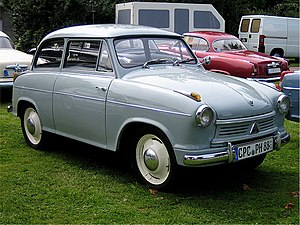Lloyd 600
| Lloyd 600 (1955-1961) Lloyd Alexander (1957-1961) Lloyd Alexander TS (1957-1961) |
|
|---|---|

Lloyd Alexander (standard)
|
|
| Overview | |
| Manufacturer | Carl F. W. Borgward GmbH |
| Production | 176,524 (Lloyd 600 & Alexander combined) |
| Body and chassis | |
| Body style |
2-door saloon 2-door Cabrio-Limousine Kombi Panel van |
| Layout | FF layout |
| Powertrain | |
| Engine | 596 cc four-stroke 2-cylinder (parallel twin) 19/25 PS (HP): 13/18 kW |
| Transmission | 3-speed manual 4-speed manual (Alexander TS) |
| Dimensions | |
| Wheelbase | 2,000 mm (79 in) |
| Length | 3,355 mm (132.1 in) |
| Width | 1,410 mm (56 in) |
| Height | 1,400 mm (55 in) |
| Curb weight | 540–580 kg (1,190–1,280 lb) (empty) 850–910 kg (1,870–2,010 lb) (loaded) |
The Lloyd 600 was a small car produced by the Borgward Groups's Lloyd Motoren Werke GmbH (Lloyd Motor Works) in Bremen between 1955 and 1961.
The Lloyd Alexander was identical to the Lloyd 600 in most respects, but in place of the three speed transmission of the 600, the Alexander featured a four-speed gear-box (and a higher final drive ratio). The Alexander was offered, in parallel with the 600, between 1957 and 1961. One difference visible from the outside was that the Alexander included an opening hatch into the rear luggage locker, whereas drivers of the 600 had to reach behind the rear seat in order to access the luggage locker.
There was also a Lloyd Alexander TS offered between 1958 and 1961 which featured a larger carburetor and a high final drive ratio, as a result of which it offered a maximum power output of 25 PS instead of the 19 PS available from the engine fitted to the 600 and standard Alexander.
The Lloyd 600 and Alexander were powered by an air-cooled two cylinder engine with a chain driven overhead camshaft. Unlike the Lloyd 400 which the 600 initially complemented and then, after 1957, replaced, the newer car featured a four-stroke engine. The cylinders were configured in parallel. The engine capacity of 596cc provided for a maximum power output of 19 PS (14 kW) at 4,500 rpm in the version supplied on the 600 and the standard Alexander, applying a 6.6:1 compression ratio. The top speed listed was 100 km/h (63 mph) and the car could reach 100 km/h from a standing start in 60 seconds. The car was fueled using "regular" grade petrol/gasoline and when driven normally consumed fuel significantly more frugally than West Germany's best selling small car, the Volkswagen. Space was at a premium in the 600 and the 25 litre fuel tank was accommodated ahead of the bulkhead underneath the front hood/bonnet in a space shared with the engine and the six-volt battery. Power was fed to the front wheels via a three speed manual gear box which used the same ratios as it had on the earlier Lloyd 400 from which it was lifted.
Sources sometimes follow the manufacturer in adding a two digit prefix to the name of the Lloyd 600 in order to differentiate between different body types as follows:
The front wheels were suspended from two transversely mounted overlapping leaf-springs, supported by telescopic shock absorbers: the rear wheels were attached to a Swing axle supported with longitudinally mounted leaf springs. The footbrake was controlled using a hydraulic linkage and drum brakes all round. The hand-brake worked on the front wheels and was operated with a cable linkage. The steering employed a rack and pinion mechanism which was conventional at the time. It required 2¼ turns between opposite locks: the turning circle was 10.45 m (34.3 ft).
...
Wikipedia
